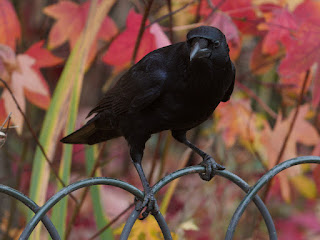The Coal Tit in the Flower Walk came to take pine nuts from my hand, getting more than a dozen of them one after the other which it stashed in cracks in the bark of a tree for later consumption. Thanks to Neil for this excellent picture.
A Long-Tailed Tit paused for a moment as the flock went along the edge of the Long Water.
A female Chaffinch perched in a treetop near the bridge.
A very short video. Pied Wagtails hunt both up and down the shore, and when there's a wind their feathers get blown about.
A Feral Pigeon at Peter Pan was inscribed with a secret message. It looks like that Arabic calligraphy where the letters are stacked one on top of another, making it almost impossible to read.
Neil also took a fine picture of a Jay in a tulip tree by the West Carriage Drive, expecting to be fed.
While on the subject of corvids in autumn leaves, here's a Magpie in an English oak almost as colourful as its American relatives.
A Carrion Crow perched in a sweetgum, planning some awful escapade.
Another crow had stolen a little packet of butter from the Lido restaurant, and enjoyed it in a place that the staff couldn't see.
The pigeon-eating Lesser Black-Backed Gull had eaten enough of his daily kill, and left the remains for the other birds. Crows pecked at it until a young Herring Gull muscled in and pulled the carcass into the water out of their reach. But the crows won in the end.
Feeding gulls is probably not a good idea, though the park gulls have not yet got the habit seen elsewhere of grabbing snacks out of people's hands. But a cloud of hovering Black-Headed Gulls is a pleasing sight.
The Black-Headed Gull with ring number EL35538 that I reported yesterday turns out not to have much of a history. It was ringed in Westminster by P.J. Belman on 22 November 2018, and no one reported it subsequently until I did. It think this was an old batch of rings that had been gradually used up over years, as the letter prefix suggests an earlier date. Anyway, here's another Black-Headed Gull I saw for the first time today, EP19104. Let's see whether there's anything more interesting to say about it.
A Cormorant in the Italian Garden caught a small carp, along with the inevitable algae which it was separating and discarding.
The borehole next to the Italian Garden, which supplies the Long Water, the Serpentine, the Round Pond and the reservoir under the Lookout, is in need of maintenance. I was told that this is why the marble fountain in the Italian Garden has been turned off for so long. With luck it should be working again soon.
A Great Crested Grebe at the island had a flap.
Tom was at Rainham Marshes, where he got pictures of two Ravens. I have never seen a Raven in England and am envious. The species is on the all-time list for the park, as one was seen over Kensington Palace in October 1889 and again in Kensington Gardens in March and April 1890. It's thought to be one of the Ravens from the Tower of London that had absconded.
He also got a shot of a Hen Harrier. This is a 'ringtail' bird; the pattern on its tail means that it's either female or juvenile.













Ah, the season when if you feed the birds at that lakeside on a working day, you must keep moving or the geese and swans will tug at your clothes.
ReplyDeleteOn that pigeon's back I see another bird on a rugged perch.
Presumably you mean you have yet to see a wild raven in England? Jim
We call these pigeons, of which there are several, the Rorschach pigeons because people see patterns in their black marks, as they do in the psychologist's ink blots.
DeleteNo, I've never seen a Raven in England at all, because I've never been to the Tower of London. I've only seen them in Norway.
I saw a Raven today while driving from work. They are quite easy to see at times. But on the other hand I have seen only a couple Crows in the wild in Spain in all my life. Weird how things work.
ReplyDeleteThe Coal Tit picture is lovely. I am envious. As I am, in a fashion, of the fellow feeding the gulls and being mobbed by the swans.
How odd that Carrion Crows should be so scarce in Spain. But these birds, so pervasive in London, can be driven out by others. In Richmond Park, a huge area, there are almost none since somehow the small shy Jackdaws have supplanted them.
DeleteFeeding a Coal Tit from your hand is indeed a magical experience and a huge privilege.
I think I've read that crows are frequent only in the northern half of the country. Certainly everywhere else it's ravens and jackdaws, which we have in excess.
DeleteThere is a to-the-death fight for nesting holes where i live among pigeons, lesser kestrels and jackdaws. Pigeons are winning by a landslide. Kestrels are expelled by jackdaws, which in turn are crowded out by pigeons.
Lovely shot of the obliging Coal Tit & an interestingly plumaged Feral Pigeon!
ReplyDeleteI'm sure you'll get to see Raven- they're definitely being recorded more frequently in the London area with Rainham & Richmond Park 2 of the better sites. I often see them when I go to the North Downs near Dorking looking for butterflies & other insects & flora.
Excellent find by Tom of Hen Harrier-much rare than Raven & a fine flight shot.
Marsh Harriers do well at Rainham, and with luck it might become a refuge for them safe from bloodthirsty gamekeepers.
DeleteLooking forward to seeing a Raven again soon.